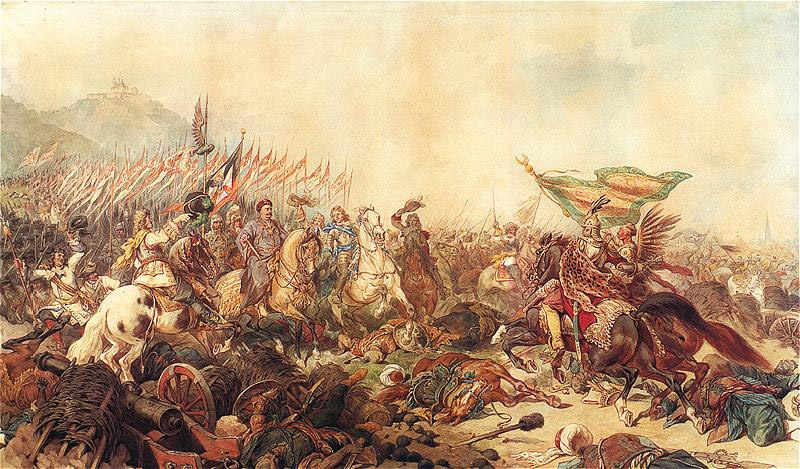few important quotations >>>
The Polish Winged HussarsSobieski at Chocim
This painting by Wojciech Kossak, depicts the husaria at Chocim, in 1621, where the Polish Army repulsed a 100,000 strong, united Turkish and Tartar army in this battleResearched and Written by Margaret Odrowaz-Sypniewska, B.F.A.angelfire.com/mi4/polcrt/WingedHussar.html
Gear at Grunwaldarchiver.rootsweb.ancestry.com/th/read/HERBARZ/2001-03/0983839431
"The hussar originated in Serbia towards the end of the 14th century. There are references to hussars in Poland in treasury returns of 1500, though they were probably in Polish service before this date. These early formations were foreign mercenaries...
Polish-Lithuanian (Winged) HussarCommonwealth Hussar, wings visible. Painting by Aleksander OrłowskiHussaren.wikipedia.org/wiki/Hussar
Light hussars
Section 4 - Arms & Armor of the Commonwealth
plcommonwealth.org/polishcostume4.doc
[i]Hussars
In the muster rolls of the armies of Poland and Lithuania, the terms 'Racowie' (Serbian) and 'hussar' or 'gussar' appear in the mid 1400's26. When you think of the grand Polish husaria, in their expensive and flashy winged armor, it is easy to forget what the root word really meant - robber! It's also interesting to note that 'robber' implies a ferocious fighter that would strike fast and hard. That implication must certainly have been on the mind of King Bathory, when he re-formed the husaria in that image.The First Polish Hussars
The first hussars of the Commonwealth were light cavalry in a support role to the 'traditional' heavily armored knights, and were formed just before 1500. You can see that documented in the painting of the battle of Orsza in 151427. They served not only the Commonwealth, but also show up in woodcuts describing their service to the Holy Roman Empire of Maximilian I (figure 8).Looking at these images, you can see how the Jagiellon Kings had drawn upon the light, hard hitting Turkish Spahi and Deli as well as the Hungarian and Serbian hussar in the creation of their own cavalry (in fact, some Serbs did serve the Commonwealth).The Fall of The Medieval Kingdom of Hungaryhungarian-history.hu/lib/warso/warso10.htm
 Sobieski at Vienna by Juliusz Kossak
Sobieski at Vienna by Juliusz Kossakmore on Polish army development >>>
Polskie pamiątki husarskie. Szable polsko-węgierskie01 październik, 2007sztuka.pl/index.php?id=124&tx_ttnews%5Bcat%5D=20&tx_ttnews% 5Btt_news%5D=818&tx_ttnews%5BbackPid%5D=119&cHash=2285583c70
The heavily armoured knights, so common in Prussia, were too cumbersome and slow against the elusive cavalries of the East and began to discard the horse-bard but their numbers still dwindled as a new type of cavalry grew prominent, called racowie.
These were light cavalry armed with lance and shield with Serbo-Hungarian origins. They found success against the Tatars using tactics of speed and maneuverability and a powerful, knee-to-knee, full gallop charge.Winged Hussar
Husaria
I'll post my collection of photos when you finish.
Please, don`t hesitate. What you have in collection?
Serbian medieval Empire was destroyed by Turks. For the centuries, Serbians lived under occupation and liberated themselves only thanks to Polish and Russian help. God bless our brothes to the end of time, for their help to us.
Serbs- ancient gate keepers were sacraficed for the good of Slavija and Europe. In its last scream, Serbian medieval Empire over Sarmatian connections gave one precious gift to Poland- ancient secret of the best cavalry skill in the world, wonderfull and magnificent concept of `knee to knee, tight formation` of riders that were absolutly dedicated to fight and that used armour and feathers as addition to their powerfull impact on enemy. `Knee to knee, tight formation` increasing powerfull effects of cavalry charge to the maximum.
What was once famous Celtic and Sarmatian cavalry stayed preserved among nobility and riders of central Serbian land of Ras (that`s why name of Racowie for Serbin riders).
Only good God knows what would be path of Serbian history if Turks didn`t appear on horizon. For sure, many Slavs wouldn`t be germanized, nor hungarized, nor enslaved.
Anyway, when i see how Poles used skills of Serbian Gusar`s and upgraded it i am proud and i know that Serbs didn`t sacrafice themselves on Kosovo for nothing. What is important to me is that knowladge and skill lived and was even increased thanks to beloved Slavic Poland. Among other reasons, that`s why i like Poland, i love my people, my sisters and brothers from Poland. Every Polish succes, for me is my personal succes and sucess of my own Serbian people.
And if our foes destroy Serbs and if God let them to do so, i won`t cry, i would continue to live for Poland and for Slavija, to the last peace of my strenght that is left.
BUT, enemy won`t pass. Serbia still stand!
Glory to Poland! Glory to the last core of Sarmatia! Poljska! Poljska! Poljska!
here are some pics of Hussars that i have >>>


Goooo Poland!
well, well
anyway, this is my favourite quotation about Polish Hussars,... best description of Hussar`s powerfull charge. Feel it >>>
Polish CavalryPoland
cavhooah.com/polish.htm
"We saw it.... the hussars let loose their horses. God, what power! They ran through the smoke and the sound was like that of a thousand blacksmiths beating with a thousand hammers. We saw it.... Jesus Maria!
--Description from Potop "Deluge" Henry Sienkievich.
Hussar in full battle dress
Thank you Poles. Oh, thank you
So, wings and feathers of Serbian light cavalry and later of Polish Hussars could be connected with the memory on original horseman equipment from glorious `Sarmatian` times, when both- Poles and Serbs were nothing but Sarmatians.
Seams that Lusatian and Balkan Serbs preserved momory on Sarmatian times, keeping once universal name of all Slavs (Sarmatian name) as their own ethnic name. Linguistic science go that far to suggest that ethnic name of modern day Lusaian/Balkan Serbs (SRBI, SRBIJANCI, SRBLJI) most probably represent some original form of Sarmatian name (even on local level) that went tru Greak and Roman/Latin transcription and was recorded in form `SARMATI`. In that scenario root SRB was crucial element in ancient original form of Sarmatian name.
As for the Poles, nobody es they didn`t preserve memory on specific Sarmatian organization and social structure. While Serbian `Sarmatism` was best preserved in the continuity of use of Sarmatian name and in military doctrine- in powerfull `knee to knee` cavalry tactic, in decoration of horses and riders, Polish `Sarmatism` included memory on practicaly all aspects of society and customs.
Europeans and Sarmatians- Polish Baroque,
by KRZYSZTOF MROWCEWICZII. Sarmatians
a. The Phenomenon of Sarmatism
The starting point for Sarmatism came froma legend about the origins of the Slavs written by Renaissance histori-ans (Marcin Bielski, Marcin Kromer), based on ancient and medievalsources. According to Pliny, early Central and Eastern Europe hadbeen inhabited by a hardened people called the Sarmatians. In the 16th century they came to be identified with the ancestors of thePoles. Poland was therefore "Sarmatia," and its inhabitants were heldto be "Sarmatians."The noble Polish youths tossed gold coins into thecrowed, the wings of the Hussars ruffled, and peacock featherswaved...
one question used to intrigues me from long time ago. It is question of `wings` that were used by Serbian Gusar Winged cavalry. As i can remind myself, cavalry `wings` are something that has its deepest roots in Serbian verbal tradition, in our epic poetry, in history.
By the research work of Polish Margaret Odrowaz-Sypniewska, she precisely state that `The wings were of Serbian origin...`
here it is >>>
By the 17th century, Polish hussars were held in even higher esteem and they made their own style of dress.The wings were of Serbian origin too.It was thought the wings were made to defend the backs of the men against swords and lassos...
previously, she already concluded that `The hussar concept began in Serbia` and she directly point on central Serbian land RAS- our ancient core of statehood and spirituality as the main source of `Winged cavalry` tradition. Here is exactly what she said >>>
In 1500, the Polish Treasury books make reference to hussars. Early on, they were foreign mercenaries, and were called Racowie from "Rascia" a word meaning "of Serbia." They came from the Serbian state of Ras.
Researched and Written by Margaret Odrowaz-Sypniewska, B.F.A.This is very important. Margaret Odrowaz-Sypniewska in her work came to the RAS.
In my belief and not only mine but also in belief of some Slavic autohtonistic theories and some other scientific theories, term and region around RAS isn`t only source of Serbian/Slavic `Winged cavalry` tradition but, being on Balkan, source of even our (Slavic in general) ethnic origin, our first foothold on European soil.
See, when i first time established connection between Serbian cavalry tradition and fact that core of that tradition coming from central Serbian land RAS (also, Rashka) i was fascinated, things automatically became clear to me. Only long and continual tradition, deep connection to the land and environment was able to produce cavalry
`that was best in the world`.